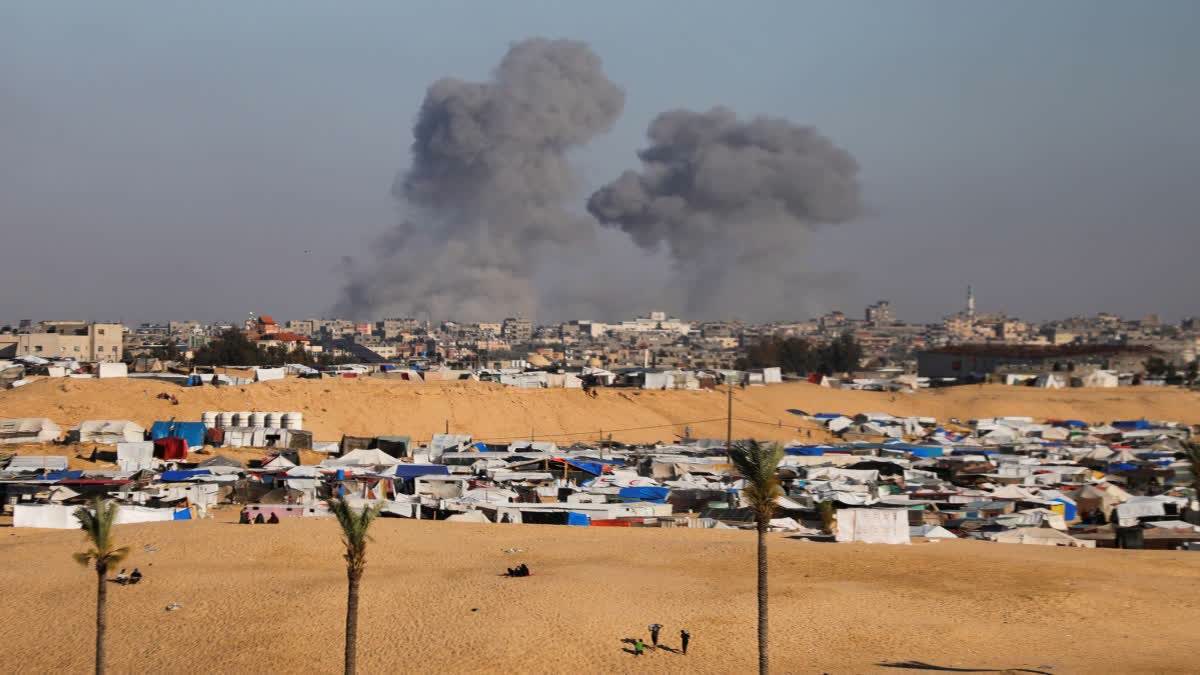Hyderabad: The Israel's military has said that it is launching targeted strikes against Hamas in Rafah, claiming it to be the latter's stronghold. Here's a comprehensive report on the history and importance of Rafah crossing.
Where is Rafah: The Gaza Strip, a narrow 41-km Palestinian territory, is situated along the eastern coast of the Mediterranean Sea. It is surrounded by Israel in the north and east. It shares its border with Egypt in the south. Rafah is located along the 12 km border that divides the Gaza Strip from Egypt.
Importance of Rafah crossing for Gazains: The Rafah crossing is the primary exit point for people from Gaza. It serves as a vital link between Gaza, often labelled as the "world's biggest open-air prison", and the world. The Rafah crossing is under Egyptian control as per a 2007 agreement with Israel.The border is Gaza's lifeline as goods and humanitarian aid cross through Rafah after Israel imposed a land, sea and air blockade on the Gaza Strip in 2007. This is the only place through which people get access to essential items like fuel, cooking gas, medicine and construction materials from Egypt.
However, the crossing remains shut for most days of the year. Even then, despite not being controlled by Israel, crossing the Rafah border is easier said than done. Palestinians have to first register with the local authorities, mostly aligned with Hamas, two to four weeks in advance. Even then, a large chunk of applications is rejected by either the Palestinian or Egyptian officials.
History of Rafah Crossing: Until the 19th century, the Sinai Peninsula was controlled by the Ottoman Empire. The Ottoman-British agreement of October 1, 1906, established a border between Palestine, which was then ruled by the Ottoman Empire, and Egypt, which was ruled by Britain. The border ran from Taba to Rafah. However, it fell into the hands of the British, which maintained control over it till the mid 20th century. In 1917, British foreign secretary Arthur Balfour declared the creation of a Jewish 'National Home' in Palestine. Israel was formally formed in 1948.
History dating back to 1979:
- 1979 Egyptian-Israeli Peace Treaty : In 1979, The Egyptian-Israeli Peace Treaty restored the border to the line drawn in 1906. This meant that Egypt regained control of the Sinai Peninsula and Israeli forces began to leave the peninsula shortly after the treaty was signed. After the last Israeli troops withdrew, the Rafah crossing point was opened as an international border for the first time making the boundary both legally and practically international. The current Gaza-Egypt border crossing was opened in 1982, after the Camp David Accords. However, Palestinians have been grappling with the uncertainty of Israel-controlled border crossings for years.
- 1994 Gaza-Jericho Agreement : The Gaza-Jericho Agreement in 1994, following the First Intifada, was a watershed moment that gave Palestine autonomy and created a new system of shared control over the Rafah crossing. This system gave the Palestinian Authority (PA) some control over security and screening procedures, but Israel kept control over most of the crossing's security and operations, as well as the power to inspect and deny access to anyone. This part of the agreement was later made null and void and replaced with almost the same language in the Oslo II Agreement. The following year then-Israeli Prime Minister Yitzhak Rabin was assassinated in Tel Aviv by a Jewish right-wing extremist opposed to the Accords.
- 2000 Ariel Sharon Incident : In September 2000, right-wing Israeli politician Ariel Sharon visited the Al-Aqsa Mosque compound in Jerusalem's Old City, which is the third holiest site in Islam and revered by Jews as the Temple Mount, their most sacred site. This was seen as 'provocation' by Palestinians, triggering the Second Intifada. This further impacted the complexities of the Rafah crossing. In 2001, Israel barred Palestinian personnel from working at the Rafah Crossing, returning it to exclusive Israeli control. This was a direct result of the Second Intifada. Israel's exclusion of Palestinian workers continued until its disengagement from Gaza four years later on September 8, 2005.
- 2005 Agreement on Movement and Access : In 2005, the Israeli government and the Palestinian Authority signed the Agreement on Movement and Access (AMA) bringing the crossing under "full" Palestinian control but with a catch. Under the agreement, Israel reserved the right to close the border and deny individuals from crossing it whenever it chooses. On June 25, 2006, Palestinian militants took Israeli soldier Gilad Shalit prisoner. Israel closed the Rafah Crossing in response to the capture, and it remained closed for a year.
- The Hamas takeover of Gaza: In 2007, the Hamas took control of Gaza and since then the border crossing has been mostly shut by the Egyptian government citing security issues in the country. Palestinians have to apply to Egyptian authorities to cross the border.
- 2011 Arab Spring : In 2011, Egyptian President Hosni Mubarak, an opposer of Hamas, stepped down following the Egyptian Revolution. This ensured the reopening of the Rafah crossing on a regular basis. However, a General Abdel Fattah el-Sisi-led coup removed Egypt President Mohamed Morsi, a Hamas ally, in 2013, closed the Rafah crossing once again.
- Covid : In 2020, following the outbreak of the coronavirus pandemic, Hamas shut the crossing, marking a rare occasion when a Palestinian government closed the border.
- 2021 Reopening: After international borders eased, Hamas and Egypt held talks and reopened Rafah crossing.
- 2023: In the early days of Israel and Hamas war, Israel airstrikes left the crossing in tatters. However, it was opened a month later and since then limited evacuations have been allowed following a deal mediated by Qatar between Egypt, Israel and Hamas. Several NGO members and passport holders have escaped the war from the Gaza Strip through this crossing.
Read more
Israel Strikes Rafah, Hours After Hamas Agrees To Gaza Ceasefire, Hostage Release



